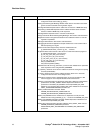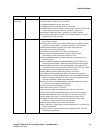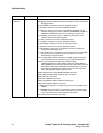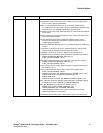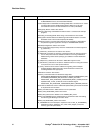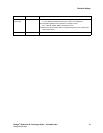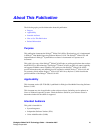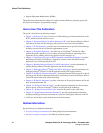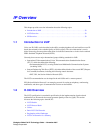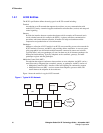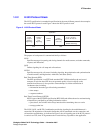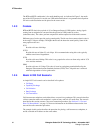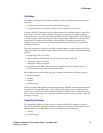26 Dialogic
®
Global Call IP Technology Guide — November 2007
Dialogic Corporation
About This Publication
• Original Equipment Manufacturers (OEMs)
This publication assumes that the audience is familiar with the Windows
®
operating system and
has experience using the C programming language.
How to Use This Publication
This guide is divided into the following chapters:
• Chapter 1, “IP Overview”, gives a overview of VoIP technology and brief introductions to the
H.323 and SIP standards for novice users.
• Chapter 2, “Dialogic
®
Global Call API Architecture for IP”, describes how Dialogic
®
Global
Call API can be used with IP technology and provides an overview of the architecture.
• Chapter 3, “IP Call Scenarios”, provides some call scenarios that are specific to IP technology,
including scenarios for the call transfer supplementary service.
• Chapter 4, “IP-Specific Operations”, describes how to use Dialogic
®
Global Call API to
perform IP-specific operations, such as setting call related information, registering with a
registration server, sending and receiving protocol-specific messages, etc.
• Chapter 5, “Third Party Call Control (3PCC) Operations and Multimedia Support”, describes
the Dialogic
®
Global Call API library’s support for scenarios where the SIP call control
application is not a direct participant in calls.
• Chapter 6, “Building Dialogic
®
Global Call API IP Applications” provides information for
building Dialogic
®
Global Call API applications that use IP technology.
• Chapter 7, “Debugging Dialogic
®
Global Call API IP Applications” provides information for
debugging Dialogic
®
Global Call API IP applications using RTF logging facilities.
• Chapter 8, “IP-Specific Function Information”, documents functions that are specific to the IP
technology and describes additional functionality or limitations for specific Dialogic
®
Global
Call API functions when used with IP technology.
• Chapter 9, “IP-Specific Parameters” provides a reference for IP-specific parameter set IDs and
their associated parameter IDs.
• Chapter 10, “IP-Specific Data Structures”, provides reference information for data structures
that are specific to the use of Dialogic
®
Global Call API with the IP technology.
• Chapter 11, “IP-Specific Event Cause Codes” describes IP-specific event cause codes.
• Chapter 12, “Supplementary Reference Information” provides supplementary information
including technology references and formats for called and calling party addresses for H.323.
• A Glossary and an Index can be found at the end of the document.
Related Information
See the following for additional information:
• http://www.dialogic.com/manuals/ (for Dialogic® product documentation)
• http://www.dialogic.com/support/ (for Dialogic technical support)



